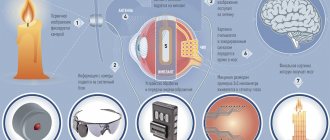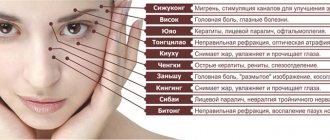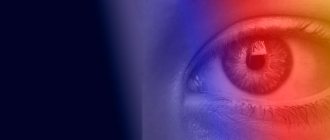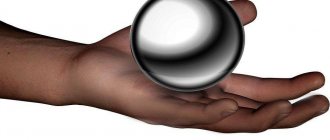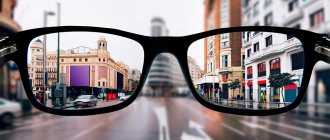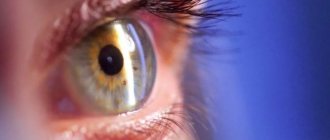A huge number of people suffer from vision problems. But despite this, many continue to remain unaware of what the mysterious diagnosis of myopia means. Other strange terms can be found in medical records: myopia, hypermetropia, ametropia, and so on. What does this mean? What is measured by dioptres and refractions? Based on the conclusions of leading ophthalmologists, we will find out what myopia is and how it manifests itself. And most importantly, is this a plus or a minus?
Share
Tweet
Share
Cool
Send
What is myopia
In medical terminology, myopia means myopia. This disease is characterized by a peculiarity of the optical structure of the retina. The focus of the image does not completely fall within the coverage area of the retina, but appears to be slightly in front of it.
This means that the optics of the eyeball will refract light to a slightly greater extent than is normally required. The light will be focused before passing into the retina, which is responsible for processing and receiving the image.
This means that myopia or myopia is a pathologically abnormal structure of the optical system of the eye. Characterized by the focus of the image falling in front of the retina, and not directly on it.
Useful video
Myopia - causes and treatment. How to restore vision:
I can’t see far—is it myopia or farsightedness?
Sometimes a person notices that he has some strangeness with his vision and perception of the world around him, but at the same time, he is not yet ready to admit that he has this or that disease.
If an image that is as close as possible to a person’s eyes is perceived clearly, with correct color rendition and sharp contours, then it means that he does not have farsightedness.
However, if objects that are far away for a person are fuzzy, blurry, and sometimes he cannot at all understand what he sees in front of him in the distance, then in this case he suffers from myopia or myopia.
Myopia is characterized by a minus index. But why is this happening? When a person purchases glasses or contact lenses that are intended for nearsighted people, he sets specific goals for them. Namely, scatter the light rays and try to move the focus of the image as close to the retina as possible. Or better yet, right at her. As a result of such manipulations, a person begins to see clearly, and most importantly, with the necessary clarity and sharpness.
Concave lenses and glasses are not just an object and an accessory. These are diopters, which are indicated by a minus sign. That is why myopia is popularly called “minus”.
Features of visual processes in people with myopia
People suffering from myopia have visual impairments that often prevent them from living their lives to the fullest. Distant objects that are further than 50 cm, that is, half a meter, are not seen clearly by them. And the further away an object is located, the more blurry its contours, dull colors and fuzzy structure it has. Sometimes this is very life-threatening if the person does not wear glasses or contact lenses.
However, as you approach this object, it will gradually begin to acquire a clear outline.
Therefore, it is very easy to identify a myopic person in the general mass of people. Sitting without glasses or even wearing them, he will, by inertia, keep the source of information as close to his eyes as possible, for example, a gadget, book, paper, and so on. This is necessary in order to see the necessary information as clearly as possible, and therefore as closely as possible.
If a person has myopia of 20 diopters, he will wear very thick glasses or lenses, which will greatly reduce the size of his eyes for the people around him.
There is also the concept of false myopia, which is also often found in medical practice.
Expert opinion
Kim Oksana Alexandrovna
Head of the ophthalmology clinic. Ophthalmologist with more than 10 years of experience.
False myopia caused by spasm, that is, simple muscle strain. These spasms control the lens of the eye. A person who tries to peer into the distance unconsciously relaxes his muscles, and the lens, which has a flat shape, stops focusing on the retina. The same thing happens, but to a greater extent when we overexert ourselves. The lens cannot concentrate on the image, so it becomes blurry and out of focus.
Constant muscle tension provokes false myopia. Treatment is carried out in the same way as for patients with myopia. A person is prescribed glasses or contact lenses that will allow him not to strain his vision when looking into the distance. Over time, the person will lower the diopter value so that the eye will independently recover to 100 percent.
What is unilateral visual impairment?
Ophthalmic diseases usually affect both organs of vision. But sometimes a person notices that his vision has become worse in only one eye. You can determine that only one visual organ sees poorly by alternately closing each eye.
A functional disorder where one eye sees worse than the other is called amblyopia. The symptom is associated specifically with dysfunction of the visual analyzer. The brain cannot compare two different images coming from the visual organs and turns off one of them. The eye becomes lazy.
Watch the video about what amblyopia is:
Causes of the disease
Ophthalmologists assure that myopia is largely not an acquired disease, but a genetic one. Therefore, parents should be especially careful when their child is in adolescence. The eye tissues have not yet worn out, but due to a sharp growth spurt they begin to stretch. At these moments, myopia may occur.
Also, other factors can worsen the situation.
- Conditions for visual work have not been created correctly. For example, you spend a lot of time on the computer, beading, embroidery, and so on. However, the lighting is poor, you are not distracted in order to do exercises.
- Heredity.
- The sclera of her tissue has weakened.
- The muscles of the lens are relaxed, which prevents it from focusing on various objects.
However, many doctors who conducted research came to a completely resonant conclusion. So, they found that sometimes myopia causes metabolic disorders. It causes tissue weakness.
Important! Myopia occurs due to an increase in the size of the back or front of the eyeballs. Therefore, in adolescence, the greatest likelihood of manifestation of such a disease appears.
Causes of myopia
Farsightedness, caused by a short longitudinal axis of the eye, is usually inherited from parents to children. After 40-45 years, due to age-related changes in the body, the refractive ability of the lens begins to deteriorate in many people, and then “senile farsightedness” occurs.
What happens?
In order for the eye to see normally, the image of objects must be focused on the retina. With farsightedness, this point of the ideal image moves away and is located, as it were, behind the retina. As a result, a person sees the picture in a slightly blurred form.
The rays coming from distant objects are parallel, and those coming from nearby objects are divergent. Farsighted eyes cope poorly with the latter. Thus, a person sees worst of all at close range and much better at distance.
There are two reasons why light rays are focused too far in case of farsightedness: a shortened eyeball or insufficient refractive power of the eye's optical system. It is also possible to have a combination of these defects in one person.
The main manifestations of farsightedness:
Farsightedness, if ignored, is fraught with such unpleasant complications as:
- strabismus;
- frequent inflammatory eye diseases (conjunctivitis);
- Amblyopia (“lazy” eye) - the eye is healthy outwardly, but sees poorly and cannot be corrected with glasses or contact lenses.
The progression of farsightedness can lead to disturbances in the outflow of intraocular fluid and, as a consequence, the development of glaucoma.
So, as already stated, farsightedness is an eye disease in which the image is focused behind the retina. The degree of development of hypermetropia depends on the eye’s ability to refract light rays and on accommodation (the ability of the lens to change its shape depending on the distance to the object):
- Weak (up to 2 diopters).
- Medium (from 2 to 5 diopters).
- Strong (more than 5 diopters).
There are two causes of farsightedness:
- The eyeball is too short, and therefore the longitudinal ocular axis is short. Most often, this visual disorder is hereditary.
- Insufficient refractive properties of the visual system. With age, the human lens loses elasticity and corresponding abilities.
There is also the possibility of a combination of these two reasons.
We talked about farsightedness (what it is), and now we will understand its causes and how the disease manifests itself.
Clinical manifestations of the disease depend on the degree of expression:
- Weak is the degree at which there are no manifestations other than eye fatigue when reading, watching TV, etc. Most of us don't pay attention to symptoms.
- Moderate – this hypermetropia is characterized by eye pain when looking at objects up close for a long time. At this stage, vision begins to blur. This can be noticed while reading, when you want to move the text away from your eyes.
- High – characterized by severe vision loss. A person begins to be bothered by a severe headache or the sensation of a foreign object in the eyes. Experts note frequent relapses of chronic diseases. If such farsightedness is found in children, this means that there is an increased risk of developing strabismus. The problem is associated with the fact that the child tries to look at objects close up, and therefore strains the ciliary muscle and brings both eyes to the nose. Farsightedness in childhood often leads to amblyopia.
How is farsightedness diagnosed?
A person can suspect the presence of a problem at the research stage using Sivtsev’s tables. If a person has difficulty seeing in the distance, doctors suggest that he look at the table through plus lenses.
Having completed viziometry, the ophthalmologist usually proceeds to the following studies:
- Perimetry is a process that determines the field of view.
- Skiascopy is a study to evaluate the refractive ability of the eyes.
- Biomicroscopy - allows you to assess the condition of the cornea, tear film and other eye structures.
- Tonometry – determines eye pressure. This procedure is performed in older people so that glaucoma can be detected in time.
- Fundus ophthalmoscopy - during this test, doctors evaluate the retina, blood vessels inside the eye, and nerves. In cases of high degree of farsightedness, redness and blurring of the contours of the nerve disc are often noted.
Sometimes the doctor may advise doing an ultrasound of the eyes, MRI and vascular angiography. These specific methods are used to clarify the most complex diagnoses.
Is it possible to have both farsightedness and nearsightedness at the same time?
So, what is farsightedness, we figured it out a little. Sometimes doctors are faced with a situation where a patient is diagnosed with two diseases with refractive errors.
One person is diagnosed with myopia and farsightedness at the same time, although this problem is very rare. This is due to the following reasons:
- presence of astigmatism;
- bad heredity;
- head injuries;
- pathologies of the central nervous system.
At the same time, the patient has poor vision in the distance and near.
In some clinical cases, doctors note myopia in one eye and farsightedness in the other. In the myopic eye, its elongation and enlargement are observed. The focus of the beam is in front of the retina. In a hypermetropic eye, the opposite is true. It is shortened and flattened. In this case, the light beam is focused behind the retina.
There is nothing terrible here if you start treatment on time. taking into account the characteristics of the patient.
poor near vision; increased eye fatigue when reading; headaches, burning eyes.
strabismus; frequent inflammatory eye diseases (conjunctivitis); Amblyopia (“lazy” eye) - the eye is healthy outwardly, but sees poorly and cannot be corrected with glasses or contact lenses.
Types of disease
Myopia has one interesting feature. It is divided into several degrees. Each degree has its own treatment methods, as well as its own characteristics.
- Mild myopia.
Characterized by an indicator of one hundred percent vision up to - 3 diopters.
With such myopia, the eye is 2 mm longer than normal. Near vision is excellent, allowing you to see clearly and clearly. However, when looking into the distance, a person sees objects somewhat blurry, with unclear contours. For example, it is difficult for him to read the name on signs that are located at some distance from him.
If the eye is 1 mm longer than necessary, then myopia drops to - 3 diopters. The larger the eye begins to grow, the more myopic it becomes.
First degree myopia is not dangerous and may not be treated, but only if vision is consistently at the same level for several years in a row. However, such people are at risk, and in order to prevent their vision from falling by a few more units, they must lead a correct lifestyle, without overstraining their eyes, and monitor their diet.
- Moderate or second degree myopia
Which glasses to choose for farsightedness: plus or minus?
→ Home treatment → Eye diseases → Farsightedness
Farsightedness is a special condition of the eye that is often contrasted with myopia. With farsightedness or hypermetropia, the focus of the image when looking at an object falls not on the retina, but behind it.
The farsighted eye is usually shorter than the healthy eye. People who suspect they have this disease often wonder whether farsightedness is a minus or a plus? The choice of glasses and treatment in general depends on this.
- Features of the disease
- What is the difference between farsightedness and nearsightedness?
- Glasses for farsightedness: plus or minus
- Treatment of farsightedness
Features of the disease
Hypermetropia is not as common a disease as myopia. It is believed that the main symptom of this condition is poor near vision, but it is worth noting that poor distance vision also occurs. Farsightedness is often an age-related problem; most people experience its symptoms after 30–40 years.
However, due to congenital structural features of the eye, hypermetropia can occur in children. In this case, it is imperative to immediately engage in vision correction; in children, such a pathology can lead to more serious problems, for example, strabismus.
In addition to decreased near visual acuity, farsighted people are plagued by a number of other symptoms that are not always immediately associated with eye problems. People with hypermetropia often experience the following symptoms:
- a feeling of tension, burning in the eyes, especially after a busy day at work;
- fatigue, periodic rather severe headaches;
- Difficulty reading small texts and looking at nearby objects.
All these phenomena are consequences of farsightedness. Without correction, this disease can begin to progress and cause more and more difficulties. The following degrees of hypermetropia are distinguished depending on the number of diopters by which vision has deteriorated:
- first degree, weak, up to +2 diopters;
- the second degree, more serious, stands out from + 2 – 2.5 to + 4.5 diopters;
- the third degree is the most severe, starting from +4.5 diopters.
In the first stages of the disease, the patient does not feel any serious difficulties; pain in the eyes may begin to appear from working for a long time. If farsightedness is detected at the first degree, the patient often only needs specialized reading glasses, which help to better distinguish small print without unnecessarily causing eye strain.
In later stages, serious discomfort may appear, and it will become extremely difficult to distinguish small fonts and nearby objects. In the third degree of the disease, visual acuity decreases not only near, but at a distance.
Important! Farsightedness almost never occurs at an early age
What is the difference between farsightedness and nearsightedness?
The main difference between these diseases is where the images inside the eye are focused, and this is where the rest of the differences between the two conditions come from. With farsightedness, the image is focused behind the retina, the rays of light are collected literally behind the eye.
With myopia, light rays are focused without reaching the retina. Therefore, with hypermetropia, a person better sees objects located far away, and with myopia, objects located close to them are better. In this regard, glasses for vision correction should be selected with different signs; each disease requires its own diopters.
Glasses for farsightedness: plus or minus
For hypermetropia, glasses with positive diopter values are required. With this disease, the optics of the eye are too weak; there are not enough plus diopters to focus the image on the retina, and not behind it.
Properly selected glasses with “plus” lenses will literally help to pull the focus of the image back onto the retina, and the patient will begin to see better. Therefore, with farsightedness, only diopters with a “+” sign can help.
It is also worth mentioning that specialized reading glasses are common for people with farsightedness. Many people with this disease are forced to move books and any other printed texts away from them at arm's length; with reading glasses, this problem is easily solved.
“Plus” glasses can be easily identified by their appearance. When worn on a person, they visually increase the size of the eye. Today, glasses for farsightedness are the most effective non-surgical method of vision correction.
Symptoms
You can diagnose myopia not only based on the visual perception of distant objects. There are certain symptoms that are characteristic of myopia in both the first and third stages.
Let's look at what symptoms we are talking about.
- The first and most important symptom is blurry objects that are located in the distance.
- Blurry of their contours.
- Near vision is clear and crisp.
- The world around you, distant from you, begins to merge into one.
Look at myopic patients. They very often squint their eyes, squinting when they try to see objects.
Another specific feature that is inherent specifically in myopia is the difficulty in translating the gaze from a near object to a distant object and vice versa.
Many patients with myopia note that they have encountered other symptoms.
- Often objects simply split into two.
- Increased sensitivity to light.
- Often so-called “black flies” run before people’s eyes.
- Some colors of objects are perceived incorrectly.
If myopia has become progressive, this is also easy to determine.
To do this, you need to systematically check the condition of your vision.
Attention! If you see that in six months the quality of vision has decreased by several units, for example, from - 3 to - 5. Even regression from - 3 to - 4 is also not the most pleasant indicator.
In this case, we can talk about progressive myopia. It is urgent to take measures to stop these processes, and therefore save your vision.
Myopia: General information
The lens and cornea, located in the human eye, transmit rays and refract them. At the same time, an image appears on the retina of the eye. This image then turns into nerve signals and travels along the optic nerve to the brain.
When the lens and cornea refract the rays so that the focus is on the retina, the image is clear. Therefore, people without any eye diseases see well into the distance.
Due to myopia, the image is unclear and blurry. This may happen for the following reasons:
- the cornea and lens refract light rays very strongly;
- the eye lengthens significantly, so the retina moves away from its normal focus location. In people with myopia, it reaches 30 mm. And in healthy people, the eye size is 23-24 mm.
People with myopia have difficulty seeing objects that are far away from them. But at the same time, when a notebook or magazine is located close to the eyes, a person sees them well.
Myopia: is it a plus or a minus?
Often, when hearing the diagnosis of myopia for the first time, people have a logical question: “ What glasses are needed to correct vision - plus or minus?” To better distinguish objects that are in the distance, you need glasses marked minus. This way you can adjust the distance between the focus and the retina.
Lenses used in glasses to correct myopia are called negative or divergent. They have a concave shape. an ophthalmologist can determine the number of minuses, or in other words, the strength in diopters . First of all, this will depend on the state of vision and the stage of myopia - severe, moderate or low.
Diagnostics
So, if you have something to worry about, you have discovered some symptoms, you need to carry out a diagnostic procedure. You need to do it both independently and in the doctor’s office.
What is the focus of the audit?
- The doctor checks visual acuity.
- Determines the degree of myopia.
- The length of the eyeball will be measured.
- The fundus of the eye is examined for the presence of dystrophy.
- The thickness of the cornea is measured.
How to check your visual acuity yourself?
At home, you can only check visual acuity, using special auxiliary tables. Visual acuity refers to the ability of the eyeball to distinguish between two points that are located at a minimum distance from each other. This is an indicator of visual acuity.
Most often, the indicator “one” is taken as the norm. That is, we can say that a person who does not suffer from myopia has one hundred percent vision.
At the same time, a person may have visual acuity that is much greater than normal, for example, an indicator of one and a half.
However, many people have visual acuity between 0.8 and 0.5. And this is also considered a healthy number.
ABOUT GLASSES AND LENSES
Is it harmful to wear contact lenses and glasses?
If glasses and contact lenses are chosen correctly, they cannot harm. Although glasses and lenses have obvious disadvantages. Glasses put pressure on the bridge of the nose, they lack peripheral vision, and in winter they have their own inconveniences: they begin to fog up when you walk into a warm room from cold air. It's difficult to walk down the street in the rain with glasses. There is always a danger of injuring your eyes, because glasses can break. Contact lenses do not have such disadvantages. However, they do not provide one hundred percent permeability of the oxygen and moisture necessary for the cornea. Frequent use of contact lenses can cause dry eye syndrome. And if you handle lenses incorrectly, there is a risk of infection.
Many myopic people complain that every few years they have to buy glasses or lenses with more and more diopters. What causes vision deterioration?
Vision deteriorates due to high stress on the eyes during prolonged work at the computer, which leads to various diseases. But this does not always mean that myopia is progressing.
If glasses and lenses are chosen correctly, your vision should not deteriorate. They can only be selected during a professional diagnosis, which includes pupil dilation. The latter allows you to completely relax the visual muscles, which means determining the true refraction of the eye and preventing incorrect correction.
On the 3Z website you can play a game and test your visual acuity. However, only an ophthalmologist can make a final and accurate diagnosis.
Tables for testing visual acuity
Tables can be of particular help in checking vision.
They are most often made of the same type of characters, which have different sizes. For children, not letters are used, but pictures.
The very first table was developed by a Dutch ophthalmologist. It is often used in foreign clinics.
In Russia, the Sivtsev table is most often used.
However, there are other high-quality ways to test vision.
Sivtsev table
This table is the most common in the Russian Federation. It is used in public medicine clinics and in private medical institutions.
Reference. The table is named after its creator, who developed it in 1925.
The sheet has letters printed on 12 lines. At the very top are the largest letters.
The lower the line is, the smaller the font is used.
On the left side of each line are diopters that characterize visual acuity.
Visual acuity is determined by viewing the table from 5 meters. With normal vision, a person can see from a similar distance up to the 10th line.
For some reason, Sivtsev decided that he would use only 7 letters from the Russian alphabet. As it turned out later, this was done so that a person with true one hundred percent vision could easily distinguish these letters at a distance of 5 m. For a person with myopia, already on the 2nd or 3rd line from the top these letters begin to merge into a single font.
Most often, such a table is used together with another, called the Golovin table.
Golovin table
This table is very similar to Sivtsev’s table. However, the image on it is completely different. Instead of letters, there are rings on 12 lines, which have connectors on different sides.
With 100% visual acuity, a person at a distance of 5 m should see everything down to the very bottom row. With normal vision, a person can easily distinguish an image up to the 10th line.
In order to understand the image that is located on each line and calculate its value, you need to divide 7 mm by the value indicated on the left side of the line.
So, the image size in the top line will be 70 mm, and on the bottom line 3.5 mm.
This table is used much less frequently, and most often together with the Sivtsev table.
However, it allows doctors to most accurately determine the patient's visual acuity.
Orlova table
There is another common table that is used in the post-Soviet space. It contains lines with pictures. There are 12 lines in total. The image size decreases from top to bottom.
On the left side are diopters that characterize visual acuity. The table is also supposed to be viewed from a distance of 5 m. Most often, such tables are used for children who cannot yet read and do not know the letters.
With normal vision, a child should see up to line 10.
The lowest picture measures 3.5 mm, while the largest is approximately 70 mm.
In order for the child to indicate the objects and the doctor to interpret what was said correctly, it is necessary to familiarize the child with the table in advance. He must understand closely what is depicted on the sheet.
Farsightedness - is it a plus or a minus?
Farsightedness (hyperopia) is a vision defect in which the eye sees objects at a distance better, but objects near are blurred.
The disease is associated with improper refraction of light by the eye.
When the eyeball is too “flattened”, which is typical for farsightedness, light rays are focused not on the retina, but behind it. This results in a blurry image.
Lenses for farsightedness “plus” or “minus”
Farsightedness is corrected by convex glasses: they are thicker in the center than at the edges. Convex lenses collect light rays and bring the image closer to the retina, focusing it clearly.
Glasses with converging lenses are “plus”. Their refractive power is measured in diopters with a plus sign.
The parameters of spectacle lenses are determined by a specialist after a thorough examination of the patient’s vision, the curvature of his eyeball and the thickness of the lens.
Causes of farsightedness
The causes of hypermetropia can be:
- the shape of the eyeball is too short, the image focused by the cornea and lens is transferred behind the retina;
- age-related changes that affect the ability of the lens to accurately focus light rays.
Glasses for presbyopia
With the development of age-related farsightedness, when the eye cannot correctly focus vision on a nearby small object, glasses “for reading” are prescribed. In many cases this is enough.
The power of spectacle lenses is measured in positive diopters and depends on the thickness of the lens, the age of the patient and the distance between the object being manipulated and the eye. Typically this distance is 30 cm.
However, with such glasses, the image of distant objects seems fuzzy and blurry. If a farsighted patient also needs distance glasses, bifocal glasses are prescribed.
Bifocal glasses have many modifications. The area of the lens used for close-up vision is located slightly lower or higher in relation to the frame. The parameters are determined by the state of vision and occupation.
For comfortable reading, a distance from the book to the eyes is required - 30-40 cm. A carpenter, accustomed to doing his work at arm's length, needs clear vision at a distance of 60 cm.
It needs a larger segment for near vision and a smaller segment at the top of the glass for distance vision.
In addition, there are also trifocal glasses. They combine three recipes.
In bifocal glasses, through the upper part of the lens it is convenient to look into the distance at a distance of 1.5 m; through the reading segment, close objects are better visible. The gap from 0.5 m to 1.5 m remains a difficult to distinguish zone. If you need to clearly distinguish everything at this distance, they resort to a trifocal spectacle lens, which provides clarity for “intermediate” vision.
To ensure a smooth transition from one zone to another, they began to make “progressively complementary” spectacle lenses. They are slightly more expensive than regular bi- and trifocal ones. Still, some distortion may be felt at the junction of the segments. Patients adapt to trifocal glasses in 5-6 days. Cosmetically, glasses with progressive lenses look more aesthetically pleasing.
Degrees of the disease
There are 3 degrees of development of farsightedness:
- Weak. Up to +2.5 diopters. There are some difficulties when reading small print at a distance of 30 cm. Long-term work causes eye fatigue, expressed in headaches and pain in the eyes.
- Average. From +2.5 to +5 diopters. Distance vision is normal, but the contours of nearby objects are blurred.
- High. From +5 or more diopters. The contours of both distant and close objects are blurred.
Spectacle correction is offered to those suffering from moderate to severe hypermetropia. Glasses are selected with glasses of the highest degree of refraction that the patient can tolerate.
Diagnostics
If the eye is not able to clearly distinguish letters at a distance closer than 30-35 cm, the text is blurred, and reading quickly tires the eyes, it is recommended to consult an ophthalmologist.
The doctor, based on the patient’s complaints, the selection of glasses or by skiascopy, will determine the nature and degree of visual impairment. The exact values of the refraction of the eye are determined at rest of accommodation.
Was the article helpful?
Rate the material on a five-point scale! (2 4.50
Is farsightedness a plus or a minus?
With farsightedness, it is impossible to see nearby objects, but distant objects are clearly visible. This happens because the light flux is not focused strictly on the retina, but is collected behind it.
To correctly answer the question posed in the title, you need to know the principle of operation of the visual system and its possible problems.
Treatment
Is it necessary to treat myopia at all? There is good news. If your disease is in the early stages, it can be treated. True, for this it is necessary to apply appropriate preventive measures. They start with eye exercises and end with taking medications and following a daily routine.
Vision loss can not only be stopped, but also brought back on track.
However, if vision deterioration has reached the middle or third stage, then in this case it is impossible to do without complex treatment and, possibly, even surgical intervention.
Drug treatment
Drug treatment is conservative.
You cannot do without it, since drugs can not only slow down the process of vision loss, but also return it to normal.
When prescribing medications, ophthalmologists divide them into three groups.
- Drugs are prescribed that are aimed at relaxing the eye muscles. They allow you to dilate the pupil and at the same time provide rest for the ciliary muscle. This measure will eliminate spasms and false myopia.
- Additionally, medications are prescribed that will provide rest for the entire visual system. Very often people cannot relax their visual apparatus even during sleep. This is very useful for people who regularly expose their eyesight to stress while working at a computer.
- Drugs that should improve the functional state of the retina. These are all kinds of multivitamins that are sent to the body by taking capsules or a course of injections. You may not know, but substances such as selenium, zinc and calcium are very useful for vision.
- Experts suggest patients use calcium gluconate every time before meals. This measure is especially necessary for children who are in puberty and are actively growing. In addition, their psyche changes.
Ascorbic acid prescribed by your doctor will help strengthen the sclera. It can be used two to three times a day for 1 month.
In order to reduce the likelihood of myopia progression and also prevent the onset of a more severe stage, you need to take medications that are aimed at improving hemodynamics.
Among them are such tools as:
- Halidor;
- Nehexene;
- Trental.
These drugs are prescribed when there is progressive high myopia.
If myopia is at the initial or second stage, then medications are prescribed aimed at preventing and treating myopia. Among the most popular remedies are Rutin and Ascorutin. They also improve blood clotting and prevent the formation of blood clots.
Optical correction
Many people resort to optical vision correction methods. This is the use of various aids that increase the sharpness and quality of the visible image.
Glasses
Any ophthalmologist will tell you that you should not stop wearing glasses during treatment. After all, constantly being in tension, due to the need to see certain objects, can negatively affect the entire course.
Wearing contact lenses and glasses is a must.
True, you don’t need to prescribe them yourself. The doctor must conduct a study to determine what your vision indicator is. He will write out a prescription for glasses, which you can present at any optician.
Glasses are made not only indicating the required diopters, but also taking into account the gap on the bridge of the nose. People who have high visual sensitivity can order lightweight glasses.
You will also be pleased with the choice of glasses. There are so many of them, and they combine a huge number of functions that will have a positive effect on your visual acuity.
For example, most glasses are equipped with sun protection and also relieve stress when working at the computer for long periods of time.
Contact lenses
Contact lenses are also a great way to improve your vision without making any changes to your appearance. After all, many people, especially girls, are against wearing glasses.
But contact lenses also have their own peculiarities. For example, not everyone can afford to wear them. The sensitivity of many people's eyes is so high that they simply cannot place a lens on the pupil.
Important! For certain categories of people it is problematic to wear lenses of a certain brand. They dry the eye and are felt.
In such a situation, it is necessary to order lenses that have a high degree of moisture.
ABOUT FEARS
Larisa Alexandrovna, what causes vision loss in general?
The human eye was created to see into the distance. However, in the modern world, we are forced to spend too much time on computers and gadgets (which means looking only from a close distance). The eye muscles simply do not have time to rebuild, and the organ itself does not have time to rest from the same work. A good example is the biceps on the arm. If you take a kettlebell and start pumping your muscles, at some point an overstrain will occur and your arm will no longer be able to hold it. The same thing happens with our eyes: if you constantly sit and look at a computer screen without moving your gaze anywhere, overstrain occurs, which affects visual acuity.
Another important factor is heredity. If either parent has nearsightedness, farsightedness or astigmatism, the likelihood that you will develop the same conditions is very high.
Both nearsightedness and farsightedness are related to the size of the eye. In the first case, it is enlarged along the anterior-posterior axis and the image is focused in front of the retina. With farsightedness, the eye is shortened and the image is focused behind the retina. In the case of astigmatism, we are talking about an anatomical feature of the eye, when the cornea has an irregular shape and the image on the retina is focused at different points (and not at one). With this disease, a person, as a rule, sees a blurry picture (there is a desire to squint to make the picture clearer).
At what age do people most often seek vision correction?
Most often these are active young people - from 20 to 35 years old who want to live a full life, regardless of glasses and contact lenses.
In general, myopia is getting younger today. This is evidenced by data not only from Russian, but also from global statistics. And again this is due to our lifestyle. Just 15-20 years ago, computers, gadgets, and phones were accessible to few people. Modern children have all this in abundance. From an early age, a person’s eyes become accustomed to working actively only at close distances, and vision begins to rapidly decline.
Already at the age of 14-15, schoolchildren are increasingly wearing glasses.
How old were the youngest and oldest patients in your clinics?
Recently, 17-year-old boys have begun to apply more often. Young people mainly come for 100% vision to enter military schools and universities. We warn them that a person grows on average until he is 18 years old (sometimes longer). The eyes also grow, like the rest of the body. They can increase by 0.5 millimeters, or by 2 millimeters. Taking into account age, you have to be as picky as possible when deciding on surgery. Ideally, vision correction should be performed after 18 years of age.
The oldest patient was 84 years old. After previously undergoing cataract surgery in another clinic, he had severe astigmatism, which reduced visual acuity. The patient did not want to put up with such injustice and was looking for an opportunity to correct the situation. We helped him with this.
Today there are practically no age restrictions for laser correction. However, we always take into account that after 45 years, the eyes have their own subtleties: they are simply not able to see equally well at two focal lengths - far and near. Even if we provide the patient with good distance vision, after 45 years he can still begin to read with plus glasses. This is due to age-related changes: farsightedness comes to all of us over the years, nothing can be done about it.
Why do ophthalmologists say that laser vision correction is good, but many people wear glasses themselves?
This is not entirely true. There are also those who have undergone vision correction a long time ago.
But, firstly, let's not forget that laser correction cannot be performed on everyone. There are contraindications due to general health and eye anatomy. Ophthalmologists are people too and may suffer from some diseases for which correction is contraindicated. Secondly, if our conditional ophthalmologist is already more than 45 years old, he most likely has developed age-related farsightedness, which I mentioned above. This means that there is a high chance that after the correction, he will simply exchange one glasses (for distance) for others (for reading).
Men over 45 often come to me and say: “I’ve never read a newspaper and I don’t intend to read it. But what I really need is to drive without glasses.” And we make a correction for him, after which he calmly drives a car and enjoys life. And in order to read a book, he simply takes glasses. It’s more difficult with women over 45 years old. Many myopic patients are accustomed to doing some small near-actions without glasses: makeup, manicure, sewing or knitting. When they find out that after laser correction they will be able to see at long distances, but will have to perform all the listed actions in plus glasses, they say: “Oh, but how will I put on makeup?”
Here everyone decides for themselves what is more important to them: wearing glasses or just reading with them.
(This is how a myopic person sees the world)
Dispel doubts: is laser correction temporary and useless?
The fact that laser correction is temporary is absolutely untrue. One of the main conditions for the operation is stable nearsightedness (myopia). If it is stable and the patient has undergone correction surgery, then the risks of vision loss due to the development of myopia are reduced to zero. Laser correction is performed on the cornea - that is, on the outer layer of the eye. During the procedure, we change its curvature and shape. Once changed, the cornea will no longer take its previous shape (either with age or under the influence of any other factors). After the operation, the diagnosis of myopia itself, of course, is not removed. The eye will still remain longer than normal (both the retina and the inner membranes will also be stretched), but it will still see well.
How reliable are today's laser correction technologies?
The first laser vision correction using the technology that underlies all modern methods was carried out 30 years ago. Since then, equipment and techniques have improved. Today, in just a few minutes, the procedure completely restores vision. And how soon a person can return to a normal lifestyle and see well depends on the capabilities of his eye.
Complications of myopia
Unfortunately, myopia is a disease that can lead to serious complications.
They are associated with retinal dystrophy. It turns out that the eyeball is stretched. Areas of tissue on the retina become increasingly stretched and in some places become very thin.
Then, at some certain point, a break occurs. And there can be many of them on the retina. Each gap contributes to a serious deterioration in vision.
And laser vision correction or treatment of progressive myopia can be done only after the patient has restored the retina. This means it will eliminate gaps.
Therefore, most likely, two operations will be planned at once.
The next point, which is also associated with complications after myopia, is possible blindness. Unfortunately, if the patient does not react in time and consult a doctor, he risks completely losing his vision. Then his return will be a much more complicated procedure.
Reasons for violation
The risk of decreased visibility in the eyes increases for people whose work involves documents or being in front of a computer monitor. In the absence of sufficient periodic rest, the likelihood of developing dangerous ophthalmological pathologies is high. An imbalance of vitamins in the body, constant stressful situations, emotional stress, insomnia and poor nutrition have a negative impact on the condition and health.
Common causes of vision problems are:
- strabismus;
- injuries;
- damage to the lens;
- pinched cervical nerve;
- past infectious diseases;
- visual fatigue;
- destructive changes in the retina or lens;
- retinal detachment.
Sometimes the cause of the condition, when objects in one eye are darker than in the other, is considered to be malignant and benign formations. In some cases, a person's vision of objects deteriorates without any clear reason, and this condition persists for several minutes and hours. In the absence of additional symptoms such as pain and fatigue, the disorder is not considered serious, but it is still worth contacting a specialist.
Prevention
If you are at risk or are simply very afraid of losing your 100% vision, you need to pay attention to the prevention of myopia from an early age.
If you often work at a computer, you must often resort to the following prevention methods.
- Therapeutic gymnastics for the eyes.
- Loads need to be dosed.
- Try to strengthen your body and immunity.
- Pay attention to proper lighting.
- Eat properly.
It is important for a person to receive balanced food, which will not only maintain vision, but also the entire body in good condition. It is better to eat in small portions. The diet must include fermented milk products, meat, fish, eggs, fresh vegetables and cereals.
But you should refuse junk food.
It is also worth spending more time outdoors, walking, playing, and playing sports.
You should also avoid strenuous physical activity, for example, lifting heavy weights.
The fact is that if you are prone to myopia, then most likely, under heavy loads on the body, it will manifest itself much faster than expected.
And finally, girls who are pregnant and are soon expecting the birth of a baby should be especially careful about their vision. If you have problems, consult your doctor early on.
You may have to resort to laser vision correction while pregnant. It is necessary to protect your vision during childbirth and pushing.
There will be enormous pressure on the eyes. If dystrophy or other eye diseases already exist, they may intensify due to a difficult birth. Unfortunately, the result can be either partial or complete loss of vision. Therefore, it is better to prevent the situation than to deal with the consequences that have already appeared.
Useful video
Prevention of myopia - myopia:
Symptoms of myopia
Symptoms of myopia include rapid eye fatigue when driving a car or while playing sports. If these are the symptoms that bother you when you wear glasses or contact lenses, you will need to be examined by a doctor and possibly change your glasses or contacts.
Myopia develops already in childhood. Children at school begin to have difficulty seeing distant objects and squint.
The main symptom is poor near vision. At the same time, the patient sees objects located in the distance well. However, over time, the pathology may intensify due to the loss of the accommodative properties of the lens.
The main symptoms, the presence of which prompts you to consult an ophthalmologist with suspected hypermetropia, include:
- Impaired near vision.
- Disturbance of “distant” vision.
- Increased eye fatigue when working.
- Visual fatigue when reading books.
- Frequent conjunctivitis and other inflammatory processes of the eyes.
- Strabismus in childhood.
This visual defect is indicated by seeing objects close to the patient well, but having trouble seeing people or objects that are located far away. Their contours become poorly visible, and details cannot be appreciated. In such cases, a person says: I see as if in a fog.
flying “flies” before the eyes; sensations of the presence of hairs on the cornea, preventing the light from focusing; the objects in question blur and double; photophobia develops, a desire to hide the eyes from the sun; distortion of color perception.
If the test for myopia and a number of symptoms indicate rapidly progressing myopia, then the patient complains of headaches, fatigue, fatigue, and a feeling of fullness in the forehead.
